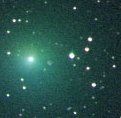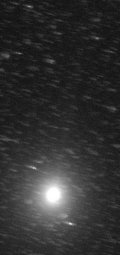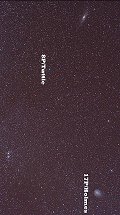| |
Summary:
After a 13.6-year absence, Comet 8P/Tuttle
is once again traveling through the inner solar system. At closest
approach to Earth on Jan. 1st and 2nd, 2008, the comet will brighten
to 5th or 6th magnitude, barely visible to the naked eye but a fine
target for backyard telescopes and digital cameras. [sky
map] [ephemeris]
[orbit] |
 |
| |
| |
Photographer,
Location |
Images |
Comments |
|


|
Mike Holloway,
Van Buren, AR
Dec. 26, 2007 |
#1,
#2, more |
RGB filters are used to image the fast moving comet. 5" TV127is refractor and ST10 xmei ccd. Second image shows the developing tail.
|
|

|
Hiroaki
Ohno,
Japan Fukushima city
Dec. 27, 2007 |
#1,
more |
Des.27.2007
19:25 JST 90mm refractor focus 500mm Canon EOS-40D (SEO-SP2)
ISO1000 120 secondes moon: Nov.2007 |
|

|
Danilo
Pivato,
Rome - Italy
Dec. 26, 2007 |
#1,
more |
2007.12.26
16h 47m U.T. Instrument: Pentax SDUF II 400/4 + ccd Sbig
ST-10XME @-30° - filter: L Exposed: 6 x 300 seconds. Site
- ROME (Italy) |
|

|
Doug
Zubenel,
Pottawatomie Co., Kansas, USA.
Dec. 25, 2007 |
#1 |
Tonight,
during the brief window of time between full darkness and
moonrise, I was able to see 8P/Tuttle with the naked eye
and averted vision!! While observing the comet, the camera
made this image. Canon Rebel XTi with a 300mm Nikkor lens
@f/5.6, 2 minute exposure at ISO 800. |
|

|
Doug
Zubenel,
Pottawatomie Co., Kansas, USA.
Dec. 25, 2007 |
#1,
#2 |
What
a Christmas gift! It was supposed to be raining or snowing
tonight, and instead I had a perfectly clear sky during
the brief window between full darknes and moonrise to make
this image that I have had in mind for weeks now. Canon
Rebel XTi with a 35mm Nikkor lens @ f/4, 4 minute exposure
at ISO 800. |
more
images (Dec. 26): from
Dave Miller of Norton Ohio; from
Fredrik Broms of Sörängen, Sweden;
|
|
|